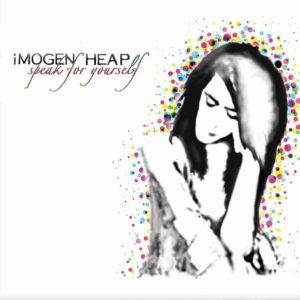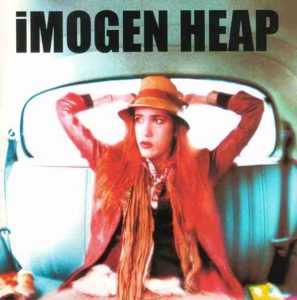
Imogen Heap has the kind of fame that’s mostly invisible.
Throughout her three decades long career, the Grammy Award-winning British musician has merged intimate, sweet, stirring vocals fused with gently sweeping electronic soundscapes into lilting, alluring, pulsating and ethereal synthesized, yet organic pop that is uniformly and captivatingly gorgeous. Perhaps not the best known music artist, Imogen Heap maintains a loyal fan base that encompasses both her devoted listeners, and music critics across every continent on the planet.
Thus, Imogen Heap has managed to build herself a successful, if low key, career that has endured for the past quarter century and more, as she remains true to herself, a self-produced artist popular on the indie concert circuit across the globe.

Born Imogen Jennifer Jane Heap in London, she was raised in Essex, where she studied classical piano from a young age, writing songs in her early teens.
While attending boarding school in her mid-teens, Imogen Heap discovered alternative pop/rock, Euro-pop, and electronica, a musical mixture that effectively ended her desire to become a classical instrumentalist.
In the musical era of the 1990s when talented, attractive young female artists were breaking out into momentous world wide fame — think, Britney Spears, Fiona Apple, Tori Amos, Aaliyah and Alanis Morissette, to name just a few outstanding artists — record companies were on the lookout for upcoming new talent.
Thus, a young 17-year-old Imogen Heap was discovered, promoted and ferried across the globe to meet music critics in major cities across North America.
VanRamblings was invited to an intimate concert featuring Ms. Heap that took place on a late evening in 1993, in the basement of the Georgia Hotel, where a gangly young Ms. Heap played a handful of songs she’d written, after which the music critics on hand were afforded an opportunity to meet with her for an interview, accompanied by a local Warner Bros. A&R rep, in a room just off the concert stage.
Long story short, Imogen Heap’s début release was not a hit, the album fading into history, and, should you look online, not included in Ms. Heap’s discography.

Although Imogen Heap’s 1998 album iMegaphone received some acclaim — Ms. Heap’s music reflecting influences including Kate Bush, Annie Lennox, and Björk — the album did not sell well, as Ms. Heap lost her contract with Almo Sounds.
All was not lost, though, as Ms. Heap’s transcendently lovely vocals caught the attention of Guy Sigsworth, Madonna’s producer at the time — who produced one of the songs on iMegaphone — who kept in touch with her after the album’s release.
In 2000, Guy Sigsworth suggested a collaboration.
In the early 2000s, Heap and Sigsworth began working together, sharing equal responsibilities in the collaborative project Frou Frou.
Despite the duo’s lighthearted name, Frou Frou utilized electronics to create an atmospheric, dreamy, and nuanced sound. MCA/Universal signed the group in 2001, and Heap temporarily put her solo career on hold.

Frou Frou released the album Details in 2002.
MCA/Universal arranged for a global concert series for Imogen Heap to support the album. Details sold like mad for Frou Frou across the European continent, becoming a massive hit for the duo, with the song Let Go topping the charts, while also being included on the award-winning Garden State soundtrack.
The success of Frou Frou allowed Imogen Heap to return to her first love: a self-produced, solo career. As Ms. Heap continued to tour across North and South America, and Europe, Frou Frou became a hit only on the European continent, most particularly in France, where Imogen Heap became a certified star.
Frou Frou and Details never took off anywhere else on the planet, save Europe, although the success of the album did serve to pay Heap’s bills, while allowing her to refocus on her career as a solo artist.

From 2003 through 2005, Imogen Heap taught herself the intricacies of the complex music production software Pro Tools (also used by Finneas O’Connell in the production of Billie Eilish’s début album).
Track 2, Goodnight and Go, from Imogen Heap’s 2005 smash hit album, Speak for Yourself.
By 2004, Frou Frou had disbanded, as Heap turned her attention to creating her first, fully self-produced album, which would become the massive hit, Speak for Yourself, which she produced over the period of a year and a half in her kitchen, responsible for every intimate detail of the album.
Track 5, Hide and Seek, from Imogen Heap’s 2005 smash hit album, Speak for Yourself.
The first smash hit off of Speak for Yourself, which sold wildly across the globe, gaining immense radio play, was Hide and Seek, the song rising to number one on the indie charts across Europe, and North and South America. Hide and Seek stops the show midway through; it’s expressly designed to make you come to a dead stop on your drive or walk like it did when it popped up in The O.C.
An a cappella blend of Heap’s hyper-layered pipes, it’s sonic trickery makes the song lap itself; there’s so much synthetic beauty in there that it comes off sounding organic anyway. Besides, it’s uniformly gorgeous; no beat required.
Imogen Heap’s voice, an ephemeral elastic thing that more often than not disappears into the music, as is very much the case with Just for Now, Track 9 on Ms. Heap’s 2005 album, Speak for Yourself.
Speak for Yourself ends with the rather melancholy The Moment I Said It, the song notable for its contrasting melodies that hint at greater possibilities in the future.
Track 12, The Moment I Said It, from Imogen Heap’s 2005 smash hit album, Speak for Yourself.
